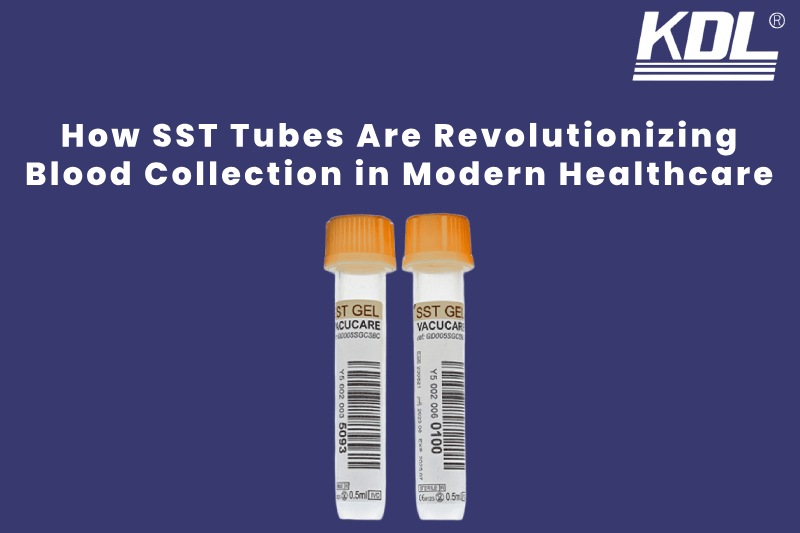
One of the most important aspects of modern healthcare is blood testing. A clean, trustworthy blood sample is the first step in any process, from tracking chronic conditions to diagnosing illnesses. The Serum Separator Tube, or SST tubes, is one of the unsung heroes of this procedure. Despite appearing to be just another vial, this inventive tube has revolutionised the ways used for blood collection, processing, and analysis.
In this article, we’ll explore how SST tubes are revolutionizing blood collection, how they work, and why they’ve become essential in hospitals, clinics, and laboratories worldwide.
What Is an SST Tube?
An SST tube (Serum Separator Tube) is a vacuum blood collection tube that contains a special gel and clot activator. It’s designed to separate the serum from the blood cells during centrifugation, making it easier and faster to obtain high-quality blood samples for diagnostic testing.
SST tubes are often identified by their color-coded yellow cap and are commonly used in clinical chemistry, immunology, and serology tests. These sterile SST tubes for safe blood handling are engineered to provide reliable performance under various lab conditions.
How SST Tubes Work in Blood Collection
The Science Behind the Tube
Once blood is drawn into an SST tube, the clot activator encourages the blood to clot. When the tube is placed in a centrifuge, the gel separator moves between the clot and the serum, creating a physical barrier. This prevents contamination and allows labs to extract clear serum for testing.
This process ensures that serum samples remain stable, even if there’s a delay in testing. The gel also minimizes the chance of red blood cells mixing back into the serum, which can skew test results. This makes SST tubes with gel and clot activator ideal for use in both high- and low-volume testing environments.
The Advantages of SST Tubes Over Traditional Blood Collection Tubes
Compared to older methods of blood sample collection, SST tubes offer a number of clear benefits:
1. A quicker turnaround time
It is not necessary to manually separate serum from blood cells when using SST tubes. As a result, test results are obtained more quickly.
2. Better Quality of Samples
Red blood cell contamination of the serum is prevented by the gel separator, yielding more precise and trustworthy results. For high-precision diagnostics, many hospitals now use leak-proof serum separator tubes.
3. A Lower Chance of Human Error
SST tubes reduce the possibility of handling errors by automating a portion of the separation process.
4. Enhanced Efficiency in the Lab
By processing more samples in less time, technicians can decrease bottlenecks and improve the overall efficiency of the laboratory workflow.
Role of SST Tubes in Accurate Blood Test Results
In diagnostics, precision is important. Whether you’re testing for hormone levels, metabolic panels, or viral disorders, even little errors might result in misdiagnosis.
- SST tubes assist assure exact test results by:
- Maintaining the integrity of the serum
- Preventing haemolysis and contamination.
- Supports long-term sample stability when kept properly.
This is especially important in clinical chemistry, where variables like potassium and glucose may be influenced by red cell disintegration. That is why high-quality serum separator tubes for blood testing have become standard in modern laboratories.
Types of Blood Collection Tubes Used in Healthcare
In a clinical setting, various blood collection lab tubes are used, each with a specific purpose:
| Tube Type | Additive | Common Use |
|---|---|---|
| SST Tube | Gel + Clot Activator | Serum-based chemistry, serology |
| EDTA Tube | EDTA (anticoagulant) | Complete Blood Count (CBC), hematology |
| Heparin Tube | Lithium/Sodium Heparin | Plasma chemistry tests |
| Sodium Citrate | Citrate (anticoagulant) | Coagulation studies (PT, PTT) |
Among these, SST gel tubes for clinical use stand out for routine chemistry panels, thyroid tests, vitamin panels, and more.
Best Practices for Using SST Tubes in Hospitals and Labs
To get the best results, proper handling of SST tubes is critical. Here are some best practices:
1. Order of Draw
To avoid cross-contamination, collect SST tubes after the coagulation tubes (blue top) and before the EDTA or heparin tubes.
2. Mixing
Gently turn the SST tube over down 5 to 6 times after collecting it to start the clotting process.
3. Centrifugation Timing
Let the blood coagulate for 30 minutes, and then spin it for 10 to 15 minutes at 1,000 to 1,300g.
4. Storage
Keep the separated serum at the right temperatures. If testing is going to take longer, it’s best to keep it in the fridge.
When utilising non-additive SST tube for laboratories or clot-enhanced variants, following these measures helps make sure that the serum is of high-quality and the test results are accurate.
Improving Blood Sample Processing With SST Tubes
Thanks to the built-in separation technology, SST tubes have streamlined the blood sample processing workflow in healthcare facilities:
- Fewer steps mean less time and fewer errors
- Batch processing becomes easier and more consistent
- Improved traceability for samples from draw to diagnosis
For busy labs handling hundreds of samples daily, vacuum-sealed SST tubes for diagnostics offer a simple but powerful way to increase speed and accuracy.
SST Tube vs. EDTA Tube: What’s the Difference?
Many people wonder about the difference between SST tube and EDTA tube. Here’s a quick comparison:
| Feature | SST Tube | EDTA Tube |
| Additive | Gel + Clot Activator | EDTA (anticoagulant) |
| Sample Type | Serum | Whole blood or plasma |
| Common Use | Chemistry, serology | Hematology (CBC, blood smear) |
| Centrifuge Result | Serum separated from clot | Plasma remains mixed with cells |
In short, SST tube is ideal for serum-based tests, while EDTA tubes are better for whole blood analysis.
Why SST Tubes Matter in Diagnostic Labs
Laboratories play a key role in modern medicine. Without accurate lab results, even the best clinical judgment can fall short. SST tube have made it easier to:
- Meet quality standards in diagnostic testing
- Reduce pre-analytical errors
- Standardize processes across lab teams
Whether it’s a small clinic or a multi-specialty hospital, SST tube for medical diagnostics are now a cornerstone of efficient, high-quality diagnostics.
Modern Blood Collection Methods in Hospitals
Today’s hospitals are constantly evolving. Modern blood collection methods rely on tools that:
- Increase patient safety
- Reduce draw times
- Improve result turnaround
SST tubes are at the center of this transformation, offering a simple yet highly effective upgrade to traditional blood draw practices. With a focus on automation and quality control, vacuum SST tube for hospital use support scalable lab operations—a must in today’s data-driven healthcare environment.
Why SST Tubes Are Good for Healthcare Diagnostics
Here are the main advantages of SST tubes in healthcare:
- More accurate findings from serum tests
- fewer contaminants and haemolysis
- Processing samples more quickly and easily
- Lab workflows that are safer and more stable
- Diagnosis and treatment planning that happen faster
SST tube for chemical blood tests let doctors make quick, smart choices while they are managing chronic care, doing regular testing, or dealing with crises.
Final Thoughts
Small changes in the healthcare field may have tremendous effects, and SST tubes are an excellent example of this. They have changed the way blood is taken and processed, making it higher quality, quicker results, and more accurate tests. SST tubes will continue to be an important aspect of healthcare diagnostics as laboratories become more modern in nature. They will help patients get better results and make things easier for doctors. It’s time to think about how SST tubes may improve the quality of treatment you provide whether you work in clinical diagnostics, phlebotomy, or hospital operations.
 +86-791-8686-1216
+86-791-8686-1216 

